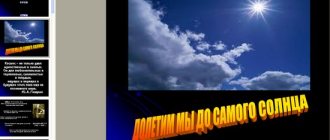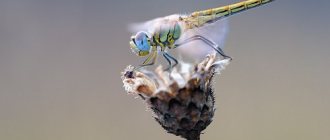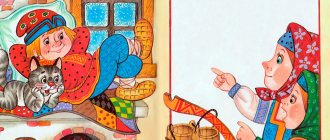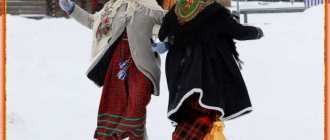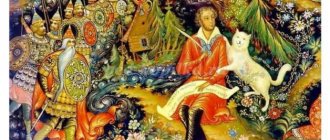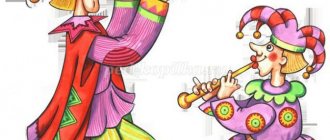Project “Russian folk tales”
Natalia Kunina
Project “Russian folk tales”
Project . " Russian folk tales "
Prepared by the project : teachers of MBDOU kindergarten No. 21 of the combined type Kunina N.V., Gordeeva N.Yu. of the middle group “Fish”
.
Project type :
• social, cognitive-creative, gaming;
• medium-term;
• group.
Project implementation period : 2 weeks (from 05/03/2018 to 05/17/2018)
.
Project participants :
• Teachers, group educators;
• Children of the middle group (children age 4-5 years)
;
• Parents.
Relevance of the project .
“Reading during childhood is primarily the education of the heart, the touch of human nobility to the innermost corners of a child’s soul.”
V. Sukhomlinsky
Many centuries ago, when there was no written language yet, oral folk art , fulfilling the same role that literature later played. People have created wonderful fairy tales for children . Works of folk art have not lost their impact on children today. Oral works reflected the deep moral ideas, dreams and beliefs of the people . The fairy tale speaks simply and convincingly about the victory of good over evil, truth over lies, and the triumph of justice. The positive hero of a fairy tale always wins .
A fairy tale is close to a child’s worldview, because he has an emotional and sensory perception of the world.
Thanks to a fairy tale, a child learns about the world not only with his mind, but also with his heart. And he not only learns, but also expresses his own attitude towards good and evil. Even children of older groups believe in fairy tales , which means that it is easier to teach and educate through it. Preschoolers learn to analyze and evaluate the behavior of heroes, develop the ability to feel and understand others, increase self-esteem, self-confidence, desire to help, sympathize with others, and most importantly, develop comprehensively.
The goal of the project : to introduce children to Russian folk tales , to create conditions for the spiritual and moral development of the child.
Project objectives :
Tasks for children:
1. Arouse interest and desire to read and listen to Russian folk tales .
2. Teach children to independently determine the main characters and the goals of their activities.
3. Learn to reason about the results of the interaction of heroes, to see the rules of life.
4. Develop children's cognitive activity, creativity, and communication skills.
5. Improve preschoolers’ methods of non-situational and personal communication.
Tasks for teachers:
1. To develop children’s knowledge about Russian folk tales .
2. Cultivate a love for fairy tales , folk art , and artistic expression.
3. Teach children to evaluate the actions of heroes.
4. Develop speech, activate vocabulary.
5. Develop creativity, fantasy, imagination.
6. Promote the development of joint creativity between parents and children.
7. To arouse parents’ interest in life in a preschool educational institution and the desire to participate in it.
Tasks for parents:
1. Participate together with the children in solving the problems of the project .
2. Develop the emotional sphere of preschoolers.
3. Develop children's creative abilities.
4. Improve communication skills with children.
5. Help and participation in the implementation of the project and the life of the group.
Products of project activities : children's works on the theme of the project “ Russian folk tales ”
: exhibition of children's drawings, modeling:
“Kolobok”
, drawing:
“Our
fairy tales ” .
Final event: Dramatization games based on fairy tales “Turnip”
,
"Teremok"
.
Collective work “Favorite
Fairy Tale ” .
Expected results.
In the process of interaction between teacher – children – parents in the implementation of the project :
Children:
1. Children will get acquainted with Russian folk tales ;
2. Children will increase their interest in telling fairy tales and looking at illustrations;
3. Through imitation of the image of fairy tale , they will learn to distinguish between good and evil; characterize actions, behavior; express emotions and understand the feelings of others.
4. The proportion of children with developed speech will increase and their vocabulary will increase.
Parents:
1. Joint activities will promote parent-child relationships.
2. The number of parents participating in joint activities will increase.
Teachers:
1. Compiling a card index with speech material (proverbs, sayings, riddles about fairy tales , fairy-tale characters ).
2. Production of joint creative works with children and parents.
3. Development of methodological recommendations for educators and parents.
4. Project .
PROJECT IMPLEMENTATION STAGES
I.Preparatory stage:
Determining the theme of the project .
Formulation of goals and objectives.
Selection of fiction, visual material (illustrations, paintings, photographs)
.
Drawing up a long-term plan for the implementation of the main stage of the project . Development of outline plans for organized educational activities.
Enrichment of the development environment.
Preparation of visual material for productive activities, didactic games, role-playing games.
Drawing up a recommended list of works of art for parents to read, watch, and discuss together.
II. The main stage of the project :
Contents of the teacher’s activities:
Change the subject-development environment in the group in accordance with the project ;
Select exhibits to create a mini-museum of fairy tales ;
Organize an exhibition of crafts and drawings “Battle of Fairy Tales ”
by teachers, children and their parents;
Select Russian folk tales and illustrations for them ;
Reading Russian folk tales and then watching cartoons based on them;
Choose board games based on fairy tales ;
Choose coloring pages based on Russian folk tales ;
Find out from children and parents what books they read at home, whether there are fairy tales .
Ask parents and their children to take part in making crafts and drawings for the decoration of the exhibition of decorative and applied arts “Look of Fairy Tales ”
.
Contents of parents' activities:
Meaningful time spent with the child, desire to take part in joint activities, common interests;
Active participation of parents in the life of the kindergarten and group;
Increasing the level of awareness of parents about the activities of preschool educational institutions.
System of activities for children.
Educational and practical part.
Morning circle “Start of the day”
:
Conversations: Introduction to the history of fairy tales : why a fairy tale is called a fairy tale ; different types of fairy tales ; fairy tales and tales about animals ; characters of Russian folk tales - what they are like ; folk tales and author's tales ; fairy tales teach ; conversation about the rules of safe behavior at home and on the street (using the plot of the fairy tales “Geese and Swans”
,
“Kolobok”
,
“Masha and the Bear”
,
“The Wolf and the Seven Little Goats”
);
watching cartoons based on the fairy tales “Geese and Swans”
,
“Girl and the Bear”
,
“Bubble, Straw and Bast Shot”
,
“Cat, Rooster and Fox”
,
“Teremok”
, etc.
Finger games: “Little Mice”
,
“Friendship”
,
“Winter Walk”
,
“Building a House”
,
“Wolf and Squirrel”,
etc.;
Outdoor games: “Baba Yaga”
(round dance,
“Baba Yaga”
) teaser,
“Catch the Kolobok”
,
“Geese and the Gray Wolf”
,
“Soap Bubbles”
,
“Blow Up, Bubble”
,
“Cat and Mouse”
,
“The Fox and the Hares”
,
“Merman”
,
“ Grandma Malanya”
,
“The Wolf and the Seven Little Goats”
,
“Geese and Swans”
,
“Cat and Mouse”
,
“Crested Hen”
,
“Golden Gate”
.
Literary Center:
Examination of illustrations of Russian folk tales , reading and telling Russian folk tales ; conversation on a fairy tale , watching cartoons, discussion of Russian folk tales ": "The Cockerel is the Golden Comb"
,
“Geese-swans”
,
“Sister Alyonushka and brother Ivanushka”
,
“At the command of the pike”
,
“Morozko”
,
“Snow Maiden”
,
“The Three Little Pigs”
,
“Zayushkina’s Hut”
,
Ryaba the Hen”
,
“Kolobok”
,
“Turnip” "
,
"The Frog Princess"
,
"Winter Hut of Animals"
,
"Snow Maiden and the Fox"
,
"Masha and the Bear"
,
"How a Goat Built a Hut"
,
"Cat, Rooster and Fox"
,
"Teremok"
,
"Fox and Hare"
,
" Fox and Geese"
,
"Fox and Goat"
,
"Fox and Crane"
,
"Zhikharka"
,
"Tar Goby"
.
Conducting board-printed, didactic, word games.
Telling a fairy tale using illustrations.
A story about your favorite fairy-tale hero based on the drawings in the book “Our Favorite Fairy Tales ”
.
Learning monologues and proverbs from fairy tales .
Cut pictures “Name the fairy tale ”
.
Art Center:
Modeling: “Kolobok”
.
Drawing: “Bubble, straw and bast shoe”
,
“Hen Ryaba”
,
“Fox and Wolf”
,
“Teremok”
,
“Cat Rooster and Fox”
,
“Wolf and Seven Little Goats”
,
“Kolobok”
.
Application: “The hut is bast and ice”
, collective applications based on
the fairy tales “The Fox and the Crane”
,
“Kolobok”
,
“The Cat Rooster and the Fox”
,
“The Fox and the Crane”
.
Construction: "Teremok"
,
"Zayushkina's hut"
.
Natural Science Center:
Conducting an experiment: “Drowning - not drowning”
(based on
the fairy tale “Bubble, Straw and Bast Shot”
).
Comparison of fairy tales "Teremok"
,
"Mitten"
and
"Jug"
.
“Book Hospital”
(book repair)
.
Center for Mathematics and Manipulative Games.
Didactic games: “My favorite fairy tales ”
, Lotto
“Teremok”
,
fairy tale is this item
from ” ,
“Name
tale ” ,
“Guess
the fairy-tale hero ” ,
“Guess
the fairy tale from the hero’s song ” ,
“Which
fairy tales are mixed up ” .
Laying out images of fairy-tale characters from geometric shapes and counting sticks.
Puzzles "Kolobok"
,
“Turnip”
,
“The Wolf and the Seven Little Goats”
.
Center for dramatization and role-playing games:
Dramatization games based on works: “Turnip”
,
“Kolobok”
,
“Teremok”
.
Role-playing game “In the theater”
.
Game "Transformation"
.
fairy tales together with the teacher : “Kolobok”
,
"Turnip"
,
"Teremok"
.
Playing out the plots of fairy tales : “The Wolf and the Fox”
,
“Cockerel - Golden Comb”
,
“Fox with a rolling pin”
.
Construction and Design Center:
Construction from a large builder "Zayushkina hut"
.
Construction using LEGO
–
"Teremok"
.
III. The final stage.
Summing up the results of project activities .
CONCLUSIONS.
The children were interested and close to the theme of the project , so they gladly took part in all the events: they learned to listen to fairy tales performed by the teacher; enjoy looking at illustrations in books. In independent play activities, familiar fairy tales are played out with the help of toys and various types of theater; Some students come up with new, their own fairy tales . The children have become friendlier; come to each other's aid more often.
Parents supported the teachers, took an active part in filling the developmental environment in the group, and showed initiative by reading more and more fairy tales ; took part in a discussion of issues about children's reading.
Thus, the work done during the project gave a positive result not only in the cognitive, speech, but also in the social development of children; and also contributed to the emergence of interest and desire among parents to take part in “ Russian Folk Tales ” project
– brought the children, parents and teachers of the group closer together.
List of used literature
1. Antipina E. A. Theatrical activities in kindergarten. – M., 2003.
2. Vasilyeva M. A. Education and training program in kindergarten - M., Mozaika-Sintez, 2009. ;
3. Veraksa N. E. Exemplary general developmental program for preschool education “From birth to school”
edited by N. E. Veraksa. Publishing house Mosaic - Synthesis Moscow, 2014. ;
4. Lykova I. A. Visual activities in kindergarten. – M., Sfera, 2007. ;
5. Kochkina N. A. Project in preschool education: Methodological manual. – M., Mozaika-Sintez, 2012. ;
6. Makhaneva M.D. Theatrical classes in kindergarten: A manual for preschool workers. – M., Sfera shopping
, 2001 ;
7. Novikovskaya O. A. “Lessons for lessons on fairy tales with children 4-5 years old ”
.
– St. Petersburg, “Parity”
2007
8. Sorokina N. F. Playing puppet theater: Program “Theater-creativity-children”
. – M., ARKTI, 2010.
Project “Russian folk tales” in the preparatory group
Yana Sharova
Project “Russian folk tales” in the preparatory group
Project “ Russian folk tales ”
Project type : Short term
Project type : educational, creative, gaming.
Duration: 1 month
Project participants : children of the preparatory group , parents, teachers.
People have created wonderful fairy tales , songs, riddles, and sayings for children Works of folk art have not lost their impact on children today. The fairy tale speaks simply and convincingly about the victory of good over evil, truth over lies, and the triumph of justice. The positive hero of a fairy tale always wins .
Thanks to the fairy tale , the child learns and expresses his own attitude towards good and evil. Even children of older groups believe in fairy tales , which means that it is easier to teach and educate through it. Children learn to analyze and evaluate the behavior of characters, develop the ability to feel and understand others.
Project goal : To introduce children to Russian folk tales .
Tasks:
- to form children’s knowledge about Russian folk tales ;
- to cultivate a love for fairy tales , folk art , and artistic expression;
* teach children to evaluate the actions of heroes;
- develop speech, activate vocabulary;
-promote the development of joint creativity between parents and children;
- to arouse parents’ interest in life in a preschool educational institution and the desire to participate in it.
Project implementation stages :
Preparatory stage:
-change the subject-development environment in the group in accordance with the program;
-select exhibits to create a mini-museum of fairy tales ;
-organize an exhibition of drawings “ Fairy-tale heroes ”
by teachers, children and their parents;
-exhibition of books on Russian folk tales
- select Russian folk tales and illustrations for them ;
-reading Russian folk tales and then watching cartoons based on them;
- select coloring pages based on Russian folk tales ;
— find out from children and parents what books they read at home, whether there are fairy tales .
-ask parents and their children to take part in the production of books for the exhibition, and also to take part in the “Give a book to a kindergarten with an autograph”
.
Main stage:
Work with children:
1. presentations; conversations; conversation about rules of behavior using the plot of fairy tales ; watching cartoons based on fairy tales ; dramatization of fairy tales ;
showing fairy tales in tabletop theaters; showing fairy tales using a finger theater; reading fairy tales and discussing their content;
comparison of the content of fairy tales read and viewed; inventing other endings to fairy tales ; retelling of fairy tales ; telling a fairy tale using illustrations ; conducting a quiz on Russian folk tales and a quiz “Guess the fairy-tale hero ”
.applique; subject drawing.
Independent activities:
- coloring of coloring books;
- modeling of fairy-tale characters ;
Working with parents:
-participation of parents and children in the design of the book and drawings “Our Favorite Fairy Tales ”
;
— participation of parents in replenishing the puppet theater group ;
-participation of parents in the “Give a book with an autograph”
.
The final stage:
-creation of the “ Fairy Tales ”
;
- registration of drawings of children and parents in the book “ Fairy-Tale Heroes ”
;
- making a book based on fairy tales .
-An evening of entertainment viewing
fairy tales "The Magic World of Fairy Tales "
.
Planned result:
-development of interest in Russian folk art ;
— development of emotional responsiveness;
- the child’s positive attitude towards the world around him, other people and himself
Project “Russian folk tales” project (preparatory group) on the topic
Kalinova Irina Nikolaevna
Position: teacher
Place of work: State budgetary preschool educational institution kindergarten No. 17 of a combined type, Kirov district of St. Petersburg
Project “What a miracle these fairy tales are!”
Project type: informational and creative.
Duration: 1 month.
Participants: children, teacher, parents, speech therapist, music director, physical education director.
Objective of the project:
Development of speech and creative abilities of children based on familiarization with Russian folk tales.
Project objectives:
Correctional and educational:
1. Clarify children’s understanding of the diversity of Russian folk tales.
2. Teach to identify the main fairy-tale characters.
3. Introduce magical objects and events.
4. Teach to distinguish between fairy-tale and real events.
5. Teach analysis of a work and the ability to make simple conclusions.
Correctional and developmental:
1. Develop children's cognitive abilities, curiosity, creative imagination, memory.
2. Develop coherent speech skills.
3. Help enrich children's vocabulary: magical, wonderful, funny, instructive, witty, smart, interesting, kind, mysterious, unusual, joyful, wise.
4. Develop the ability to give a moral assessment of the actions of fairy tale heroes.
5. Improve intonation expressiveness of speech.
6. Develop articulatory, fine and gross motor skills.
7. Promote individual self-expression of children in the process of productive speech and creative activity.
8. Develop aesthetic taste, the ability to see, appreciate and cherish beauty.
Correctional and educational:
1. Foster love for native culture through Russian folk tales.
2. To cultivate responsiveness, sociability, and friendliness in children.
3. Cultivate diligence, the habit of being busy, working diligently and accurately, finishing what you start, and respecting the results of others’ and your own work.
4. Develop the ability to work in a team: willingness to accept a common plan, desire for coordinated actions, ability to support partners, unite the children's team.
Relevance:
Mastery of the native language and speech development is one of the most important acquisitions of a child in preschool childhood and is considered in modern preschool education as the general basis for the upbringing and education of children. L.S. Vygotsky wrote: “There is every factual and theoretical basis to assert that not only the intellectual development of a child, but also the formation of his character, emotions and personality as a whole is directly dependent on speech.”
The most fertile soil, with unlimited developmental and educational opportunities, is the Russian folk tale.
Russian folk tales reveal to children the precision and expressiveness of the language, showing how rich their native speech is in humor, lively and figurative expressions. The amazing power of linguistic creativity of the Russian people has never manifested itself as clearly as in folk tales. Their inherent extraordinary simplicity, brightness, imagery, and ability to repeatedly reproduce the same speech forms and images make it possible to put forward fairy tales as a factor in the development of coherent speech in children.
The all-encompassing genius of Pushkin, who drew the content and power of his immortal works from the creative depths of the people, even he needed the spiritualizing influence of a fairy tale.
K.D. Ushinsky called the fairy tales of the Russian people the first brilliant attempts at folk pedagogy. Admiring fairy tales as monuments of folk pedagogy, he wrote that no one is able to compete with the pedagogical genius of the people. They are a treasury of folk pedagogy; moreover, many fairy tales are pedagogical works, i.e. they contain pedagogical ideas. Leading Russian teachers have always had a high opinion of the educational significance of folk tales and pointed out the need for their widespread use in pedagogical work.
Unfortunately, at present, not all educators see the multifaceted possibilities of this area of their activity and do not fully use its spiritual and moral potential. Therefore, the theme of the project “What a miracle are these fairy tales” is relevant.
Problem:
Difficulties in children developing coherent speech, the sequence of stories about the events of their lives, the ability to retell literary works, compiling stories based on a picture and a series of pictures, and compiling descriptive stories.
Children's creative abilities are poorly developed.
Planned results:
1. Increasing the effectiveness of work on the development of coherent speech in children.
2. Enrichment of children's vocabulary.
3. Children’s use of elements of Russian folklore, comparisons, metaphors, epithets and other means of figurative expression in their speech.
4. The ability to play didactic and printed board games, solve and compose your own riddles, solve crosswords and puzzles based on Russian folk tales.
5. Application of acquired knowledge, skills and abilities in creative activities.
Stage I “Preparatory”
1. Study of literature on project activities.
2. Preparation of methodological literature, illustrated books with Russian folk tales, illustrations and reproductions based on the plots of Russian folk tales.
3. Development of lesson notes, a quiz script on the topic “What a miracle are these fairy tales!”, a script for the New Year’s holiday “On the roads of Russian folk tales.”
4. Enrichment of the development environment: in the book corner - the introduction of Russian folk tales, illustrated by different artists; illustrations, postcards depicting fairy tale characters as you study; in the speech zone - the introduction of didactic and board-printed games on the topic; production and gradual introduction of theaters (on flannelgraph, flat, tabletop, on sticks, on spoons, on cones, Bibabo, glove, finger, puppets); in the play area - masks, elements of costumes of fairy tale heroes;
in fine arts - coloring books depicting plots and heroes of Russian folk tales, materials for creative works, reproductions of paintings based on Russian folk tales; music - Russian sundresses and kosovorotki for all children.
Stage II “Information and creative”
Cognitive development:
1. GCD: “Russian folk tales.”
2. FEMP (educational games): “Blocks of Dienesh” – “Ivan Tsarevich saves Vasilisa the Wise” (labyrinth), “Palace”, “Tower”; “Fold the pattern” - “Magic Apple”, “Girl Snow Maiden”, “Snake Gorynych”, “Bunny”, “Boat”; “Cuisenaire’s Sticks” – “Teremok”, “Bunny”, “Mouse”, “Cockerel”, “Emelya”, “Palace”, Frog Princess”, “Ivan Tsarevich”; “Geokond” – “Sivka-Burka”, “Terem”, “Ship”.
3. Construction: “Build a castle for Helen the Beautiful” (builder); “Frog Princess”, “Firebird”, “Bunny” (origami).
Speech development:
1. GCD: Retelling of the fairy tale “Fear has big eyes.”
GCD: Storytelling based on a series of pictures “Fox-Sister and Wolf.”
ECD: Creative storytelling: “Come up with the end of a fairy tale.”
2. Telling fairy tales using sketches and mnemonic tables.
3. Compilation of descriptive stories about heroes and magical objects of Russian folk tales. Children come up with riddles on the topic.
4. Children telling fairy tales compiled at home with their parents: “A fairy tale in a new way.”
5. Didactic games: “Find out the beginning of the fairy tale”, “What comes first, what comes next”, “What fairy tale did the hero (heroine) come from?”, “What is the name and title?”, “What fairy tale is the magic thing from?”, “ Choose an illustration for the fairy tale”, “Confusion”, “Fold the picture and find out the fairy tale”, “Which hero does the proverb fit to?”
6. Solving crosswords and puzzles on the topic “Russian folk tales.”
7. Reading fiction: “The Cockerel is the Golden Comb” (comparison with the plot of the fairy tale “The Cat, the Rooster and the Fox”), “Geese-Swans”, “Sister Alyonushka and Brother Ivanushka”, “Sivka-Burka” and “Ivan the Tsarevich” and the Gray Wolf" (comparison of fairy tale plots), "At the behest of the pike", "The Tale of Baba Yaga", "Seven Simeons", "Morozko", "Snow Maiden", "Finist - Clear Falcon", "Flying Ship", "Magic ring".
Social and communicative development:
1. Game-dramatization based on the Russian folk tale “Snow Maiden Girl”.
2. Playing out plots from fairy tales: “The Wolf and the Fox”, “Cockerel - Golden Comb”, “The Tale of Baba Yaga”.
3. Conversation: “What would you do if you had a magic wand?”
4. Guessing riddles.
5. Learning proverbs, rhymes, and poems by heart.
6. Printed board games: “Favorite fairy tales” (“We play and learn”), “My favorite fairy tales” (“Umka” educational games - find out by the shadow), “Tales about animals”, “Fairy tales. Game on the road" (with chips), cubes "Favorite fairy tales", theater of fairy tales ("Games on your table" OKSVA).
Physical development:
Outdoor games: “Geese-Swans”, “Golden Gate”, “Cat and Mouse”, “Two Frosts”, “Grandma the Hedgehog”; physical exercise “Fairy Tales”; finger gymnastics “Favorite Tales”, eye and breathing exercises.
Artistic and aesthetic development:
1. Consideration of illustrations for Russian folk tales by illustrators E. Rachev, V. Konashevich.
2. Examination of reproductions of paintings by V. Vasnetsov “Alyonushka”, “Ivan Tsarevich on the Gray Wolf”.
3. Drawing “Based on Russian folk tales” (watercolors, crayons, felt-tip pens).
4. Drawing with sand “Based on Russian folk tales.”
5. Applique “Decorate a sundress, a shirt-shirt for a Russian costume.”
6. Application from leaves based on Russian folk tales “Magic Leaves”.
7. Modeling “My favorite heroes”.
8. DIY theater.
9. Theater teacher show based on fairy tales: “Zayushkina’s Hut” (Bibabo), “Cockerel and the Bean Seed,” “Snow Maiden Girl” (planar), “Cat, Rooster and Fox” (on cones), “Khavroshechka” (tabletop) , “The Frog Princess” (on flannelgraph).
10. Watching cartoons based on your favorite Russian folk tales.
11. Performance in the garden “Based on Russian folk tales.”
12. Music: selection of musical material for playing out the plots of fairy tales, Russian folk songs, round dances, musical folk games.
Collaboration between parents and children:
1. Reading Russian folk tales suggested by the teacher at home.
2. Creative works from natural materials, made by parents and children at home.
3. Compiling fairy tales in a new way, designing baby books.
4. Bus excursion to the ethnographic museum: excursion: “The bunny had a bast hut...”.
Working with parents:
1. Consultation for parents “Parenting with a fairy tale.”
2. Screen “What a miracle these fairy tales are!”
3. Parents making various types of theaters (knitted heads for a finger theater, fairy tale heroes on cones, drawing fairy tale heroes for a flat theater and theater on a flannelgraph).
4. Parents make attributes and elements of costumes to play out the plots of fairy tales.
5. Sewing of Russian sundresses, blouses, costumes of fairy-tale characters by parents.
Stage III “Final”
Project results:
1. The group has created the necessary conditions for the formation in children of a holistic understanding of Russian folk culture.
2. Children's horizons have expanded and their vocabulary has become more active.
3. Children's speech has become expressive and emotionally charged.
4. Children play out the plots of familiar fairy tales with interest and pleasure, play in different types of theaters, didactic and printed board games based on Russian folk tales.
5. Children use the acquired knowledge, skills and abilities in their creative works.
6. Parents actively participated in introducing children to Russian folk tales, performing creative work based on their plots, making costumes and theaters, as well as in the final quiz.
Project product:
1. Exhibition of children's creative works based on fairy tale plots (drawings, applications, sand painting, leaf applications, modeling).
2. Exhibition of creative works from natural materials, made at home with parents.
3. Little books “A Fairy Tale in a New Way” (children and parents).
4. Theaters made by the hands of children, parents, teachers and their assistants.
5. Costumes made by parents.
6. Quiz “What a miracle these fairy tales are!” (children and parents).
7. Presentation “What a miracle these fairy tales are!”
8. Photos and video materials of the quiz “What a miracle these fairy tales are!”
Literature:
1. Antipina E.A. “Theatrical activities in kindergarten: games, exercises, scenarios.” M.: TC Sfera, 2003.
2. Bityutskaya N.P. — author-compiler. “System of pedagogical design: work experience, projects.” Publishing house "Teacher". Volgograd, 2012.
3. Dzhezheley O.V. “Kolobok.” Literary games and fun" M.: "Prosveshchenie", 1994.
4. Doronova T.N. “We play theater: theatrical activities for children 4-6 years old: method. manual for teachers of preschool educational institutions." - 2nd ed. - M.: Education, 2005.
5. Esaulova N.A. "Lesson notes on eloquence." Educational and methodological manual. – M.: Center for Pedagogical Education, 2007.
6. Kartushina M.Yu. “Summaries of logorhythmic classes with children 5-6 years old” - M.: TC Sfera, 2005.
7. Kudryavtseva N.Yu. “We are getting ready for the holiday. Methods for making costumes, dolls, and scenery for a children's performance." - M.: School Press, 2011.
8. Makhaneva M.D. “Theater classes in kindergarten: A manual for preschool workers.” —: M.: Sphere shopping center, 2001.
9. Naumenko G.M. “Folk children's creativity: a collection of folklore materials” - M.: ZAO Publishing House. Tsentrpoligraf, 2001.
10. Novikovskaya O.A. “Lessons for lessons on fairy tales with children 5-6 years old”
St. Petersburg: “Paritet”, 2007.
11. Polyak L.Ya. "Theater of fairy tales: scripts in verse for preschoolers based on Russian folk tales." - St. Petersburg: “Childhood-press”, 2008.
12. Smirnova O.D. “Design method in kindergarten. Educational field “Reading fiction” - M.: Publishing house “Scriptorium 2003”, 2011.
13. Ushakova O.S., Gavrish N.V. “Introducing preschoolers to literature: lesson notes” - M.: TC Sfera, 2005.
